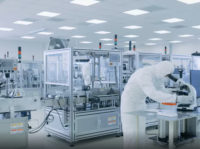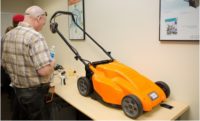While you may be familiar with the concepts behind additive manufacturing, the inspection methods themselves may not be as well known.
Dr. Marcin B. Bauza explains how the manufacturing industry is undergoing a paradigm shift with additive—as well as facing challenges that may crop up along the way. Dr. Bauza is the head of ZEISS Additive Manufacturing Process and Control and the vice president of new technology & innovation, ZEISS Industrial Quality Solutions, at Carl Zeiss Industrial Metrology LLC.
While additive manufacturing is complicated, a cooking analogy can help. Dr. Bauza explains, “Imagine you buy the nicest kitchen oven. It doesn’t mean you can cook a good dinner. You need to know recipes and how to do it.”
“Additive is so new,” he says, so that instead of learning recipes from your parents or grandparents, “no one talks to each other. Everyone tries to cook by themselves without talking. Without feedback, just cooking and trying recipes over and over. But they aren’t learning from others or getting the results they want.”
“It’s the same situation now with additive,” he says. The situation is this: manufacturers buy powders from the same vendor. In theory, the lot is identical, but in practice it could be slightly different. When users print a part, using the same exact printer, which they’ve programmed themselves, with specific laser settings, they expect results to be the same. However, this is not always the case. The metals might have a different grain structure, which could affect the mechanical properties.
“If we understand what is coming into the machine and what is coming out of the process, it’s possible to learn and develop proper recipes,” Dr. Bauza says.
“Today it takes the aerospace industry three to four years to develop a recipe that is good enough for what they are looking for,” he says. “What we want to do is enable industry, between different tools, powder and post-process, to shorten time to development, from years to weeks.”
In the past, 3D printers would be used simply for prototypes. But now we’re at the next stage, Bauza explains, and companies have to “ensure that material properties and shape accuracies are really where we want them to be.”
This is no small task. But looking to other industries can provide an idea of to expect.
Consider the casting industry of the 1960s, he says. Originally, people thought putting casted parts into jet engines would never happen. The parts were thought to be too brittle for flight. But today, a great majority of jet engine components are casted parts. This is because over the years the industry controlled the process and made sure it was extremely reliable. The challenge on the additive side is the same.
The technology involved in the additive manufacturing process includes powder analysis and post-process analysis, Dr. Bauza says, and it’s important to pay attention to all of the information available from the process. “By connecting this data flow,
he says, “users are able to diagnose the problem, and ensure that their yield is what they want.” And, if something goes wrong, they find out quickly. Dr. Bauza offers the example of a 40-hour build process. If something goes wrong in the beginning, you don’t want to wait 39 hours to find out there was a problem.
“Now the industry is ready to start discussing that topic,” he says. “Before, the mindset for most was: quality is important in and around the process.” Some people think if the process is controlled, there is nothing else to worry about, he says, but this is not the case.
If users are able to collect data in the beginning, along with during printing and after, it will be easier to determine how and why problems come up. For example, if porosity is discovered in a particular region, it will be possible to use the data to find out that porosity may be because how it was printed, the powder used, or how the powder was used. “If you have enough inputs, you’re able to determine the problem,” he says.
Through a partnership with Oak Ridge National Laboratory, Zeiss is dedicated to additive manufacturing in industry. This includes the all-important area of measurement and inspection. In many cases, additive manufacturing relies on a range of tools for inspection. For example, if you only use computed tomography to inspect the parts, “you know just one flavor of the problem,” Bauza says. But if you have other data points to refer to, you can get a better picture of the issues.
With scanning electron microscopes, X-ray, and computed tomography, there are a range of tools to help with additive manufacturing results. Dr. Bauza likens this approach to using Google Earth. When you zoom out, you have a larger vantage point, but when zooming in, you see more details. With computed tomography, it would be possible to see issues like porosity or cracks. If you wanted the full picture you would be able to stitch the data together to determine what factors are affecting the process. With this view, users could learn more about the materials, and potentially even create materials with better properties, he explains.
The industry is learning, along with academia, he says, much like another industry. Dr. Bauza describes the computer science industry of 30 years ago. Back then, in order to program a computer, you would need to know DOS. Today, someone with no concept of programming is able to use a computer perfectly.
The same goes for additive, he says. “Today we’re at the DOS level.”
As additive manufacturing continues to grow, imagine what the next ten, twenty or thirty years might bring.




